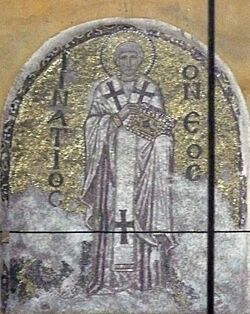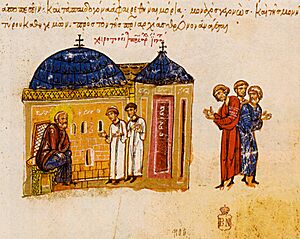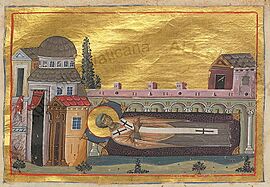Ignatios of Constantinople facts for kids
Quick facts for kids SaintIgnatius of Constantinople |
|
|---|---|

Ignatios of Constantinople, Northern tympanon, Hagia Sophia, Istanbul
|
|
| Patriarch of Constantinople | |
| Born | 798 Constantinople (modern-day Istanbul, Turkey) |
| Died | 23 October 877 (aged 78–79) Constantinople (modern-day Istanbul, Turkey) |
| Venerated in | Catholic Church, Eastern Orthodox Church |
| Canonized | Pre-Congregation |
| Feast | October 23 |
| Ignatius of Constantinople | |
|---|---|
| Ecumenical Patriarch of Constantinople | |
| Enthroned | 847 |
| Reign ended | 858, 867–877 |
| Personal details | |
| Denomination | Chalcedonian Christianity |
Ignatius (also spelled Ignatios) was an important religious leader in the 9th century. He served as the Ecumenical Patriarch of Constantinople, a top position in the Eastern Christian Church. He held this role twice: first from 847 to 858, and again from 867 until his death in 877. Both the Catholic Church and the Eastern Orthodox Church consider him a saint, and his feast day is celebrated on October 23.
Life of Ignatius

Ignatius was born around 798 in Constantinople, which is now Istanbul, Turkey. His birth name was Niketas. He was the son of Emperor Michael I Rangabe and his wife, Prokopia. His grandfather was also an emperor, Nikephoros I.
When Niketas was a child, his father was removed from power in 813. To prevent Niketas from ever becoming emperor, he was made ineligible for the throne and became a monk. This meant he dedicated his life to religious service. He later founded three monasteries on the Princes' Islands, a group of islands often used to send away members of the imperial family who became monks.
Becoming Patriarch
In 847, Empress Theodora chose Ignatius to become the new Patriarch of Constantinople. He replaced Patriarch Methodios I. Ignatius was a strong supporter of icons, which are religious images. He was against those who had previously tried to ban or destroy icons.
Soon after becoming patriarch, Ignatius got involved in a disagreement within the Church. This was about whether to remove religious leaders who had supported the banning of icons in the past. Ignatius sided with the group that wanted to remove these leaders. He even removed the archbishop of Syracuse, Gregory Asbestas, who was a leader of the opposing group. Asbestas then asked Pope Leo IV in Rome for help. This started a period of tension between the churches in Rome and Constantinople.
Conflict and Exile
Ignatius was also a strong critic of Bardas, who was a powerful regent (a person who rules for a young emperor). In 857, Emperor Michael III and Bardas removed Empress Theodora from her influence. Because of this, Ignatius lost his support and was forced to resign as patriarch in 858.
A highly educated layman named Photios replaced Ignatius. When Photios changed some of Ignatius's policies, Ignatius's supporters appealed to Pope Nicholas I. The Pope at first tried to stay out of the argument but later spoke against Photios in 863. The main issues in this conflict were who had more authority – the Pope or the Patriarch – and who had control over the newly converted Christian region of Bulgaria.
Return to Power and Death
In 867, a new emperor named Basil I the Macedonian took the throne. He wanted to form an alliance with Pope Nicholas I. So, he removed Photios and brought Ignatius back as patriarch.
Once Ignatius was back in power, he convinced the Bulgarian prince to remove the Latin (Roman) Church leaders from Bulgaria in 870. Even though Ignatius and Photios had been rivals, they actually had similar views on some important Church matters. Photios was later brought back to teach the emperor's children.
Ignatius passed away in October 877. After his death, Photios was once again made patriarch. Photios even helped in the process of Ignatius being recognized as a saint.
See also
 In Spanish: Ignacio de Constantinopla para niños
In Spanish: Ignacio de Constantinopla para niños
- Council of Constantinople (861)
- Council of Constantinople (867)
- Council of Constantinople (869-870)
- Schism of 863


